Genre: Shmup Developer: Wolf Team Publisher: Renovation Players: 1 Released: 1990
“Leon Todo — one of the last great sharpshooters, fights for private enterprises. His strong will drives him to the battlefield. In September 2016, he came to Japan while the summer still lingered. A female agent of PEID (Private Enterprises’ Intelligence Department) contacted him and game him a floppy disk with a job request. The agent was later found dead, by unknown hands. Leon accepted the assignment, and he traveled to Tobora. In Tobora, he found a Super Mobile Weapon,” the Hypertek-Cannon Tank, Granada.
So goes the manual to WolfTeam’s wonderful 1990 shooter, Granada. We can only wish Leon good luck with reading that floppy disk in 2016; maybe he can drive his Granada around Tobora and look for a 286 PC still lingering in some pawn shop. Though the game’s story does invoke a pilot hero character, Leon stays put inside his battle tank as with most every shooter, only emerging for the ending credits. The world of Granada is a dangerous place — the manual warns the reader that “the ground beneath the clouds is home of dangerous starving wolves,” so Leon should be careful not to fall thousands of feet from the surface of the flying battleship, “Astarsha,” lest he have to contend with them. However a tank did board the surface of a flying aircraft in the first place, the manual doesn’t say.
So, ignore the typical shooter silliness and plot holes and enjoy the game! Granada is a top-down shooter offering free movement without the forced scrolling which has since defined the genre. As in Super Fantasy Zone, the player must destroy several specially marked targets before getting a crack at the stage’s boss enemy. These targets range from the tank hangers in Tobora to Shuba’s mobile cannons to the Astarsha’s well defended engines. Of course, these targets are not alone as numerous other lesser enemies will strive to stop Leon throughout the game. Leon will have to use the level’s unique layout to avoid shots and retaliate as he moves from target to target. What keeps Granada fresh is that unlike most other shooters, where each new level simply yields more bullets to weave through and bosses with greater health, each of Granada’s nine levels is a unique playing experience with its own set of obstacles and challenges. One level is dark except for a searchlight trained on the Granada, another features a gauntlet of super tanks to plow through, while yet another has Leon deactivating gates to advance through the stage.
The graphics have held up quite well, as Granada remains a visually detailed game with a variety of locales. Though the Granada itself and many enemies are on the small side, it allows for many threats on screen at once with minimal slowdown. There isn’t much parallax present as many of the levels having Granada affixed to the ground, but on those occasions when the tank finds itself high above there are forest and cities visible below. Animation, likewise, is pretty sparse, though it does not detract from the game at all. Given the small size of the basic enemies and player tank, animation is limited mainly to turning in eight directions. There are some very nice scaling and rotation effects on the boss enemies, and the smoothness of these effects may surprise players given the early release of the game.
Whereas the levels in most shooters are essentially filler until the boss, the stages in Granada are uniquely challenging, and that extends to the boss designs as well. Instead of just being a massive target spitting out waves of bullets, the bosses in Granada often require interesting strategies to dispatch them, such as ricocheting shots off walls so that they strike the boss’s vulnerable rear or having a boss throwing up an invincible shield when fired upon, forcing the player to wait then attack. The bosses are a real treat and typically will chase down the Granada throughout the level, turning the entire stage into a battlefield for the encounter.
These levels are pretty large, and Granada navigates them with the aid of a radar in the lower right corner of the screen which identifies the location of the tank, the targets it must destroy, and that level’s boss enemy. The tanks in 2016 move fast, and Granada is no exception. The Hypertek-Cannon Tank whizzes along at a fast clip – faster than any Galaxy Federation fighter – and makes movement about the levels a breeze. The tank moves at maximum speed with a press of the D-pad and stops on a dime when let go. Further aiding the Granada’s mobility is the control scheme, particularly the “Locked Cannon” button, effectively a strafe trigger which freezes the tank’s position allowing it to track a target while evading enemy projectiles. Despite the hype of the game’s storyline, the Granada is a little tank facing great danger at every turn, and winning requires using the tank’s speed and maneuverability to its fullest.
A fair number of hostiles are dispatched by ducking behind some wall and strafing back-and-forth, pecking away at the more powerful threat until it’s defeated. When the Normal shot isn’t enough, Leon can unleash the Blaster weapon, a much larger and stronger cannon that pushes the tank back with each use. There is a slight delay between Blaster shots, though it offers the same unlimited ammo as do the Normal shots. While it would seem that the player would rely on the Blaster throughout the entire game, there are many times when the Granada will find itself surrounded by bottomless pits or other dangers where the Blaster’s knockback can prove disastrous if fired.
Though the Blaster weapon is powerful, it is not a bomb found in most shooters. Granada does offer power-ups, however, though Leon must scout the level to locate them. There are five unique bonus units available, one type per level, but they do not carry over to the next stage. The Reflector is a cube which loosely follows the Granada and fires a scattershot; the Paul-vanian is a shield which can be launched that stops and fires at enemies before returning to the tank; Chromleck is an orbiting semi-homing shot; Epalet offers Leon long range missiles; and Hidden detonates when touched, destroying all enemies within its blast radius. The free roaming units can attack enemies behind walls, allowing Leon to park Granada at times and allow the bonus item to dispatch threats before proceeding onward. While not necessary to win (the standard weapons are more than enough to deal with any obstacle), finding these units is still a welcome addition to Granada’s arsenal.
Yet, the greatest threat Leon faces is not the enemies but rather the timer. Given the free roaming nature of the game, Granada employs a clock within which Leon must accomplish all the level’s objectives and defeat the boss. The difficulty settings (easy, normal, hard, and mania) directly impact the amount of time on the clock, and there is no shame in playing the game on the easiest setting. Granada’s levels are large and often mazelike, and a wrong turn can kill via wasted seconds on the clock. Numerous false trails and dead ends turn Granada into a game of memorization at the more difficult settings, as the timer will not be kind to errors in Leon’s travel plans from target to target. Beyond the timer, the game’s levels are not terribly challenging given the tank’s ability to duck behind obstacles and avoid bullets entirely without having to weave through them much. Granada also employs a health meter, and it takes several shots to bring down the tank. Finally, destroyed enemies remain destroyed throughout the level, and the lack of respawning threats and targets – even when the player dies and has to replay the stage – make completing the game more bearable than many other shooters on the system.
Timer notwithstanding, it is the ease of play, freedom of movement, reasonable difficulty, and great presentation which makes Granada so much fun to play. The graphics are solid, the control is flawless, and the music hypes the player for the challenge ahead. Not to slight Wolf Team, but if the developer’s name was not on the game, I would assume this was a Technosoft product due to the outstanding quality and great soundtrack. Though the music can get drowned out by explosions sometimes, the background music is catchy and memorable, a somewhat more upbeat sound to the sound chip rock that dominated the shooters of the day. Even the muffled voice of the announcer who calls out the bonus units’ names when acquired sounds like the same gagged woman used in the Thunder Force games.
So why isn’t Granada on the same level as the more renowned 16-bit shooters? Perhaps it got lost in the flood of shooters early in the Genesis’ life, or maybe the poor advertising (using small screen shots and misleading descriptions) failed to entice people to give Granada its audience? Then again, maybe people just don’t like free roaming and/or tank shooters, as games such as Jackal, Guardian Force, and Iron Tank are few and far between. Is it the lack of Jamie Bunker? Whatever the case, Granada is a terrific and solid title which deserves to be in any shooter fan’s library. It’s nothing that will set the world on fire – obviously Granada is fairly obscure when it comes to the other established shooters of the day – but the level of innovation, playability, and presentation have kept and will keep the game from going stale over the years, making it as enjoyable in 2016 as it was in 1990.
SCORE: 8 out of 10

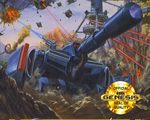
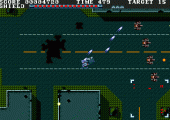
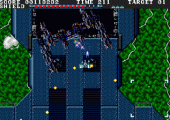
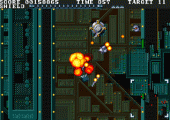
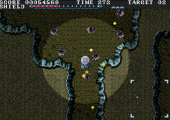
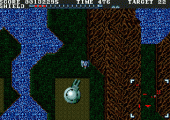
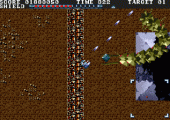
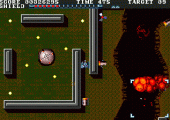
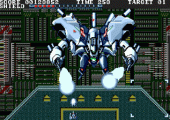
I would rate as the hardest stage in this game as the one where orange enemies are shooting multidirectional pellet shots and wormlike objects are momentarily becoming a trail of fire. Even on Easy and 6 lives, this stage took 2 continues to get past.